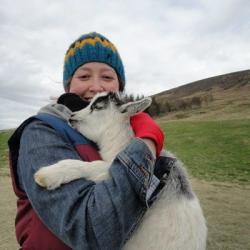Hannah Kent's "Burial Rites"
Based on the real story of Agnes Magnúsdóttir, who in 1830 became the last person to be executed for a crime in Iceland, ‘Burial Rites,’ the debut novel by Australian author Hannah Kent, is the culmination of ten
years’ of writing, research, and obsession-what the 26-year-old winner of the Writing Australia Unpublished Manuscript Award describes as her “dark love letter to Iceland.”
Lyrically written, meticulously researched and swiftly plotted, `Burial Rites’ takes an infamous figure in Icelandic history and transforms her from “the spider, the witch caught in the webbing of her own fateful weaving,” into a believably complex character with motivations more pure than evil. Indeed, Kent writes that her book was intended to “supply a more ambiguous portrayal” of a woman who many sources credit with being manipulative and conniving, the brains behind a vicious double murder staged while the victims were asleep.
When the novel opens, Agnes’s fate is already sealed: she has been found guilty of murder and arson and sentenced to death. Although convicts at the time were generally sent to Denmark for execution, it was, in the case of Agnes and her co-conspirator, determined to be more “economical,” to behead them both locally (the public execution may have also been intended to make an example of the harsh penalty for murder). While awaiting her execution, however, Agnes is sent to live and work with the family of a district officer, and to be advised by a young and inexperienced reverend so that she might repent of her crime before her death.
Kent crafts the narrative, and our picture of Agnes, through her protagonist’s own voice as she relates her life story to Reverend Tóti, through letters (based largely on original documents), and through the eyes of several secondary characters. The story is peppered with myriad small details which manifest the often grim daily lives of Icelandic peasants in the 19th century. We glance through a croft’s window, fitted with “dried sheep’s bladder that had been pulled across to serve as a pane.” We join Agnes in the painstaking process of hand-making blood sausage, “up to my elbows in the guts of things, working towards a kind of survival.” Occasionally, these quotidian details feel a bit forced, as when the narrator points out “a young woman wearing the national headdress of cap and tassel,” or when Agnes describes a sound which “lingered in the air like a cloud of ash over a volcano.” But mostly, they are discreetly interwoven in the narrative, adding an extra degree of reality to the story.
Agnes comes to be known to her host family as a hard worker, a woman with considerable domestic wisdom (she deftly delivers a breeched baby) and literary knowledge (she knows many sagas by heart), and of a principled, if proud, character. She’s written as something of a poet, infusing her speech and memories with melodic descriptions of the countryside, the weather, and daily tasks: “I sway back and forth and let gravity bring the scythe down and through the grass, until I rock steadily. Until I feel that I am not moving myself, and that the sun is driving me. Until I am a puppet of the wind, and of the scythe, and of the long slow strokes that propel my body forward. Until I couldn’t stop if I wanted to.”
In one of her interviews, Ms. Kent stated that part of her fascination with Agnes’s story lay in the fact that accounts of the woman lacked nuance. “When I heard people use the word `monstrous´ in connection to Agnes and her actions,” she stated in an interview with Australia’s ABC News, “there was part of me that thought, `but no one’s really a monster.’” Such compassion is clearly what allowed Kent to fully embody this story, and yet it is also the novel’s main weakness. For it is not, ultimately, that difficult to compel a reader to empathise with a downtrodden, misunderstood, educated, but uncared-for woman–especially when that woman’s crime is revealed to have sprung from mercy and love, rather than hate or vengefulness.
How much more might an author of Kent’s obvious talent have accomplished if only she had helped us empathise with a woman who was just a bit of a villain–a little selfish, a little less self-assured and less poised? When correcting or recasting history–when creating a lasting portrait of a real human being–it is not, perhaps, any less questionable to create a martyr than a monster.
Buy subscriptions, t-shirts and more from our shop right here!
















